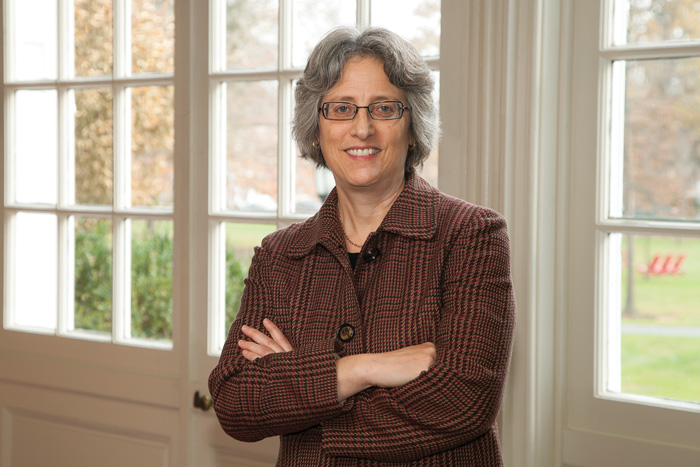Dickinson Matters: Partners in Learning

Student experiences illustrate the transformative power of what is at the core of our educational model
Nancy A. Roseman, president
On any given day across campus, you will find students and faculty engaged in conversation. Whether discussing class material over coffee in The Quarry, wrestling with the complexity of organic chemistry or the cell cycle in front of a whiteboard in Rector or sharing experiences and advice during impromptu advising sessions in Adirondack chairs on the academic quad, these interactions are both ordinary and extraordinary—they are fundamental to the Dickinson experience. We are so proud of our student-faculty ratio of 9:1 and of a faculty who devote themselves to generation after generation of Dickinsonians.
Our distinguished faculty are scholars, researchers, authors and teachers, but more important, they are mentors, colleagues and partners in what is ultimately a reciprocal experience. During the past five years, more than 350 students have worked directly with faculty on a multitude of research projects. It is a testament to the quality of the research proposals of our faculty that a number of these opportunities receive funding from prominent organizations like the National Science Foundation, NASA and the Andrew W. Mellon Foundation in such a competitive funding environment. Many more are endowed opportunities funded by generous alumni and friends.
We are proud that innovations within our curriculum encourage collaboration and deep learning between faculty and students. It should come as no surprise that this highly engaged pedagogical approach is as rewarding and inspirational to a faculty member as it is to a student. Nor are opportunities for collaboration any longer confined to the traditional classroom or lab, as many students have found meaningful intellectual and artistic enterprises in some of the farthest corners of the world.
The Global Mosaics program is an illustration of the collaborative and immersive teaching and learning experiences taking place at Dickinson. Based in countries such as Brazil, South Africa and Peru, the programs are unique in their intensity, interdisciplinary reach and engagement in their communities. Faculty members make invaluable connections for students, linking them to subject matter and local experts and showing them how to apply lessons from the field to their everyday lives.
Take Carley Zarzeka ’15, who enrolled in the Norway-based Global Mosaics program to study sustainable practices in public art. She and six others worked alongside local Norwegian artists, learning how the environment affected art within the community and exploring and making art. From Norway, Carley traveled to Toulouse, France, where, for several weeks, she and 13 fellow students worked, lived, ate and studied alongside their professors.
Most meaningful for Carley were the intentional ways in which the traditional boundaries between student and faculty broke down. While the students were painting or sketching, faculty worked alongside them, pausing to review, reflect and make recommendations on their work. This level of hands-on involvement and mentoring deeply affected Carley, allowing her to be more expressive, confident and mindful of the creative process.
Will Kochtitzky ’16’s first foray into field research came during his first year, when he traveled to Bolivia to collect soil samples and conduct interviews with farmers for a faculty-led archaeological expedition. Subsequent trips to British Columbia, Greenland and Iceland enabled him to study pillow-lava formations, paleoproterozoic metaphoric rocks and glacial erosion—objects and phenomena that may offer empirical evidence to enhance our knowledge of changes in the Earth’s climate over hundreds of thousands of years.
Last fall, Will enrolled in the Global Climate Change Mosaic and attended the 20th Conference of the Parties to the United Nations Framework Convention on Climate Change in Peru. While there, he and a fellow classmate initiated a partnership with the Volcano Observatory of Peru in Arequipa for his earth-sciences capstone thesis. Experiential and field-based opportunities with Dickinson faculty also gave him opportunities to work with state-of-the-art equipment in labs on campus, and he believes that he has thrived at Dickinson because of his intellectual partnership and ongoing mentorship with faculty members.
Carley’s and Will’s experiences illustrate the transformative power of what is at the core of our educational model: Dickinson faculty and Dickinson students working closely together, resulting in our students seeing the world, and themselves, in new ways. I’m sure that many of you reading this are reflecting on your own relationships with faculty that have continued to have a positive impact on you. Ensuring that future generations of Dickinsonians have access to similar opportunities will require the continued support and generosity of the entire Dickinson community. I hope you are as inspired as I am to make a difference in the lives of our incredible students.
Read more from the spring 2015 issue of Dickinson Magazine.
Learn more
Published April 14, 2015